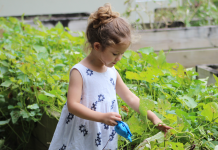We want to raise kind and compassionate humans. To do this, it’s so important that we talk openly about diversity in people with our children. This includes talking about gender identity. Talking openly about complex topics gives children the words they need to talk about themselves and those around them. It helps them feel safe to explore and talk about their identity with us. Many of us are unsure how to go about this – not because we don’t want to talk about, but because we don’t know how.
There is not one right way to talk about gender identity (although there are definitely some harmful ways). Below are some tips that I’ve found helpful as we’ve started talking about gender with our child. Our kiddo is a young toddler, so adjust as needed if your children are older. Take what resonates with you, leave what doesn’t.
Start Having Conversations Early
I’ve heard more than a few times “kids are too young to learn about gender identity,” but I’m calling BS on that. Children start to recognize the construct of males and females between 18 and 24 months. Most children understand by age four if they’re considered a boy or a girl (of sex assigned at birth). We also want to have these conversations early, because children don’t have the biases or misunderstandings about gender identity, gender roles, and gender norms that begin not long after that.
Read Books About or Inclusive of Gender Identity
I found it incredibly helpful to read books – both on my own and with my toddler. Below are a couple of my favorites:
Being You: A First Conversation About Gender by Megan Madison, Jessica Ralli, & Anne/Andy Passchier
I cannot recommend this book enough. These authors have the unique ability to take complex concepts and break them down in a way that is easily understood by all. It’s appropriate for my toddler, but also for older kids. Each page tackles a smaller piece of gender identity, including discussion questions to guide conversations with your kiddos. They also have books about race, consent, and love – all of which are phenomenal.
It Feels Good to be Yourself by Theresa Thorn
This book does a great job of defining what different words mean, such as transgender, cisgender, and non-binary, and does so in a way that is easy to understand. I’d recommend this one for younger kids in the range of 3-6.
The Relationship Between Anatomy and Gender
Growing up, most of us were taught that boys and girls have specific body parts. We hear this from babyhood on. While anatomy does determine a child’s sex assigned at birth, it doesn’t determine what gender they will be as they grow. It’s important that we keep that distinction clear.
Try to do so without othering transgender and nonbinary experiences. When we say, “We’re all given a gender a birth, but some people grow to be a different gender,” we imply (whether we mean to or not) that cisgender experiences are the preferred norm, and transgender or nonbinary experiences are the less desirable exception.
Instead, we can say, “We’re all given a gender a birth. Some people grow up and are the same gender they were given at birth; some people grow up and realize that they’re a different gender than they were given at birth; some people grow up and realize they aren’t a boy or a girl.” Cisgender, transgender, and non-binary experiences are all defined and there is no implied preferred norm.
Don’t Reinforce Gender Stereotypes or Norms in Your Home
Let’s allow our kids to be kids, without our biases. We live in a society that wants to divide everything into “for boys/men” and “for girls/women,” which is highly problematic for a myriad of reasons.
There is no such thing as “girl books and clothes” and “boy books and clothes.” Children should be able to play and express themselves in the way that feels best to them. Confining them to what is “approved” for their gender prevents them from doing so. The system also leaves out a lot of people who do not identify as male or female. Not everyone exists in that binary.
Let your kids play, learn, and explore safely on their terms. If your daughter wants to play with trucks, awesome. If your son wants to paint his nails and dress up like a ballerina, great. They aren’t hurting anyone, and it’s completely normal for kids to try out new things. Same thing with clothes.
If your child’s expressed interests fall into what’s considered “right” for their gender, that’s okay – as long as they had the chance to explore and try things outside of that. It’s okay if your daughter likes to wear pink and your son wants to play football. We just want kids to come to these decisions on their own and not as a result of reinforced gender stereotypes.
Talk About and Practice Using Pronouns
Pronouns in general can be difficult for young kids. With our kiddo, we approach pronouns as language that people use to express their authentic self.
My kiddo isn’t to an age where she really uses pronouns (she calls everyone by their name and refers to them by that), so we’ve only had a few conversations about pronouns. For toddlers and really young kids, I’ve found the following works:
“That person’s name is (insert name here) and (insert name again) is a (she, he, they)”
Gently correct your kiddo if they use the wrong pronouns, just like you would if they used the wrong name. It doesn’t need to be a big deal and it doesn’t need to stop the conversation. We’ve also talked with our toddler that we can always ask someone what their pronouns are if we don’t know.
If Your Kids Have Questions, Do Your Best to Answer Them
When kids ask questions, it’s an opportunity to learn. More importantly, shutting the conversation down sends the message that the topic is something to be ashamed of. It creates a stigma. A person’s gender identity is never something they should be ashamed about. It’s not always easy. Kids have a knack for asking very blunt and very loud questions in public spaces. And of course, everyone in the vicinity hears. Just do your best.
These conversations might seem difficult at first, but just like any other topic they get easier and smoother the more we engage in them. Let’s raise our children to be their authentic selves and to treat the authentic selves of others with respect.












